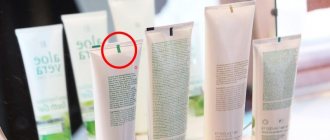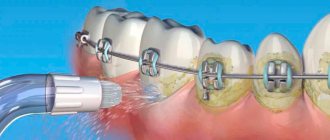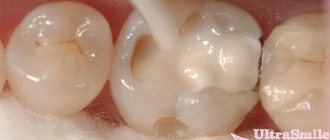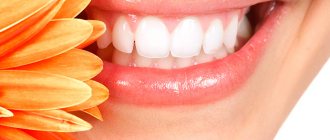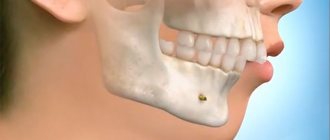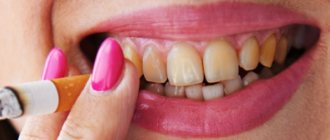Ideal antiquity
Researchers were surprised, but during excavations they often discovered remains dating back to the first millennia BC with perfect teeth (until about the 9th century). Against this background, it was concluded that in ancient times toothache was rare for people. This is explained quite simply. Firstly, the main diet of the ancient inhabitants of the Earth consisted of raw vegetables and coarse foods, which provided the necessary massage of the gums. There was also no sugar and other sweets, which are known to have a bad effect on the condition of tooth enamel, quickly destroying it. And, of course, people didn’t live as long as they do now. The average life expectancy was 20-25 years. And during this time, even today, not everyone’s teeth deteriorate.
From toothbrush to toilet paper. History of hygiene products Read more
Dental treatment tools
None of us likes having a special drill put into our mouth to grind down a tooth. Fortunately, professional dentists do this in a less painless manner, trying to eliminate the problem. But how did Neanderthals treat their teeth? After all, they did not have such tools.
When David Fryer, a paleontologist at the University of Kansas, showed his dentist the teeth of a Neanderthal man who lived 130,000 years ago, he was pleasantly surprised by their condition. Outwardly, they were very similar to the teeth that people living in the 21st century have. Scratches were noticed on the surface of the enamel, as if they had been caused by a toothpick.
No need to run to the store: lazy dumplings are prepared simply (in a frying pan)
Red is the hit of the season: several trendy shades using the balayage technique
WHO commission to find the original source of COVID goes to bat caves
You should also pay attention to the work of archaeologists that was carried out in Italy. After excavations, it was revealed that ancient people used various methods to eliminate the infection. In some cases, they chipped teeth with a sharp small piece of silicon.
Dubilo
But progress did not stand still, human life changed, a certain comfort appeared, and closer to the 1st century AD, ancient people became acquainted with such an unpleasant phenomenon as tooth pain. True, back then they did not stand on ceremony and teeth were simply removed. Moreover, they did this with the help of a special tanning machine, first made of stone, and then of metal. The “doctor” had to have remarkable strength to eliminate the source of pain with one blow.
However, having lost their teeth, people realized that they could not last that long: there was nothing to eat. Therefore, the first ideas about treatment began to appear. It was this period that was marked by the appearance of the first dental drill (today it is a drill). According to researchers, even in the Mayan Empire, doctors practiced drilling small holes in the enamel to remove pus from the tooth to alleviate the suffering of the patient. To do this, they used jade or copper sticks, which they rotated quickly enough with their hands. Naturally, there was no anesthesia, but since there was no alternative either, there was nothing to choose from.
A more scientific approach to dental therapy dates back to the 6th century BC. e., when the famous Indian doctor Susrut compiled a classification of dental pathologies and determined the main directions in treatment at that time.
Modern times: the birth of science
The French doctor Pierre Fauchard did a titanic job during his life, essentially giving rise to modern dentistry. He systematized all known knowledge about teeth and the oral cavity, compiled descriptions of almost one and a half hundred dental diseases, and in the first half of the 18th century he brought it all into one work, from which dentists began to study. Around the same time, they began to be considered separate specialists.
Fauchard invented new instruments and types of prosthetics, even creating an ingenious system of lenses and mirrors to illuminate the patient's mouth. People appreciated his efforts - there was no end to clients, and Fauchard had to open the first dental school, which recruited the same jewelers. His students subsequently acquired their own students, and this is how the new dentistry spread throughout Europe. At the same time, she appeared in Russia along with European doctors, who were often hired by Peter I.
In the 19th century, Americans began to use drills and dental chairs en masse - and dental clinics are not much different from modern ones. True, at first, drills operated from a simple foot drive, so dentists had to work not only with their hands, but also with their feet. Only by the 20th century were they replaced by electrical devices with an unattainably high drill rotation speed.
Wax fillings, wooden jaw
Ancient Egypt left descendants with a huge layer of material for study: both cultural and medical. For example, descriptions of dental treatment can be found in the drawings on amphorae. Doctors in Ancient Egypt learned how to make the first fillings: they were created from ordinary beeswax. True, the design was not particularly reliable: the wax fell off in pieces while eating, and the fillings had to be changed.
The Egyptians also learned how to skillfully make and use false jaws. They were made from hardwood.
Curious about treatment methods. How our ancestors coped with diseases Read more
Litter in the ear
The Romans tried to advance carefully in medicine. They treated dental health with special trepidation. Cornelius Celsus, an advanced doctor of that time, suggested rinsing teeth with certain compounds that could relieve a person of pain. If the patient did not feel better, then they resorted to tooth extraction. But no one used knocking out anymore; instead, the fabric was slightly trimmed, then the tooth was loosened, and then removed with forceps.
Lotions based on bird droppings (mostly crows or sparrows) were recommended by Pliny. A mixture of droppings and oil had to be placed in the ear on the side where the tooth hurt. It was also Pliny who was credited with a rather unexpected recommendation: in his opinion, the patient should catch a toad on a full moon, spit in its face and cast a certain spell. In addition, they tried to treat teeth with the help of enemas and laxatives.
Toothworm and ancestral spirits: The most amazing myths about teeth
June 27, 2018
Neanderthals also suffered from toothache. They were most likely the first to try to explain where teeth come from and who gnaws holes in them. By the time the first civilizations emerged, different peoples already had hundreds of myths about teeth. Many of them turned out to be surprisingly tenacious.
AT THE DAWN OF TIME
Ancient legends say: God initially created Adam toothless. Realizing that something was missing, the Creator started the process of forming teeth - one every day. In total, 30 of them grew, and this is what determined the number of days in the month. However, this legend is refuted by excavation data, according to which our distant ancestors had as many as 44 teeth - 12 more than we have. Over the years of evolution, one incisor and two premolars have disappeared on each side (both above and below). This happened due to the fact that humanity switched from raw meat to soft, thermally processed foods. As a result, the “unnecessary” teeth gradually disappeared and the jaw became smaller. By the way, followers of Buddhism suspected something similar: according to their legends, Buddha had 40 teeth. At the same time, they were very white, there were no gaps between them, and the length of all the teeth was the same - the Buddha did not have fangs.
Fangs are generally not very popular among ancient peoples. In many cultures they are considered the focus of the animal nature in humans. Apparently, their similarity to the teeth of predators played a role here. Among many African tribes and Australian aborigines, young men still have their fangs knocked out during initiation to emphasize the difference between people and animals. It is believed that if this is not done, a person can go wild and even turn into a beast.
Among many European and Asian peoples, it was considered a bad omen if the first tooth that erupted in a baby was a fang. Europeans were sure that such a child would grow up cruel and bloodthirsty, and Asians believed that he was connected with evil spirits, so the mother and the “fanged” baby were driven out of the village so as not to bring trouble to the entire tribe.
| Teeth encrusted with precious stones discovered in Mayan treasuries and burials |
There are no fewer myths associated with newborns who are born with teething. These children were treated differently. For most European peoples, this was tantamount to being born in a shirt and promised the child a happy fate. But among some tribes of Southeast Asia and Oceania, “toothy” newborns were considered either potential sorcerers, or even the product of evil spirits - with all the ensuing consequences.
By the way, Hippocrates called the first teeth milk teeth: he was convinced that they were formed from mother’s milk. He argued that the mouse should pick up the fallen milk teeth, then the new teeth will grow strong and healthy, and the child will have a happy and rich life. |
The appearance of baby teeth in a baby has tormented parents since ancient times. To alleviate their suffering, the Roman writer Pliny the Elder advised hanging an amulet made from the teeth of a wolf or horse around the child’s neck. This was supposed to ensure painless teething and peaceful sleep for the parents.
Simply throwing away lost milk (and not only milk) teeth was categorically prohibited by the traditions of various nations. It was believed that health and luck were thrown away along with them, and the sorcerer who found the tooth would be able to gain unlimited power over its former owner. The ancient Slavs collected a necklace from fallen teeth, which became a powerful amulet for the person to whom they previously belonged. The Japanese buried the teeth of their children under a tree so that new ones would grow just as strong. The Indians kept their fallen teeth in beautiful caskets, which after death they burned along with the deceased. The Mayans encrusted their children's lost teeth with turquoise and precious metals and kept them in the family treasury. The Ottomans rolled their teeth into bread crumbs and fed them to the birds for good luck.
Many of these beliefs have survived to this day, including in enlightened England, where a lost tooth is sprinkled with salt and then burned so that a dog’s tooth does not grow in its place. Molars cut much easier than milk teeth, but only until the turn of wisdom teeth comes. “And why are they needed!” - groans an adult whose jaw suddenly swells and his mouth stops closing. However, our ancestors did not think so at all. For example, Zoroastrians were sure that the absence of at least one of the four wisdom teeth meant that a person was deprived of the blessings and protection of the ancestors, which worked only with a full set of “eights.” It was believed that the reason for such a misfortune was the desecration of the entire family due to closely related marriages in a person’s pedigree.
Some Slavic tribes had a similar myth: it was believed that if a person loses his wisdom teeth, he will also lose the protection of his ancestors. “Eights” were a kind of talisman, and even the pain in the process of cutting through them was a good sign: the more difficult they were for a person, the more luck they brought.
So for a happy life, representatives of most nations needed to grow all 32 teeth. However, Aristotle argued that 32 is a male prerogative. Women, in his opinion, had only 30 teeth. The authority of the thinker was so great that for a couple of centuries no one even thought of counting the teeth of representatives of both sexes! Even the inquisitors, who used tooth extraction from witches as torture, did not refute this myth. In addition, Aristotle, and after him his followers until the enlightened 18th century, were confident that teeth can grow throughout life. And for some reason no one asked the question: why aren’t they growing?
A LITTLE ABOUT DENTAL BEASTS
One of the oldest and most persistent myths, which originated in hoary antiquity and survived right up to the 19th century (and in some places to the present day), is the myth of the toothworm. Even Sumerian sources claimed that holes in teeth are gnawed by small worms that dig holes for themselves. The nameless author of one of the oldest cuneiform tablets asks the heavens: why, why did the gods give man to be devoured by these disgusting creatures, and did not strike the voracious tooth-eater “with the power of their hands”?
The toothworm was mentioned by the authors of Ayurveda and doctors of Ancient China, doctors of the pharaohs and ancient authors, scientists of the Arab East and Indian shamans |
The worm was mentioned by the authors of Ayurveda and doctors of Ancient China, physicians of the pharaohs and ancient authors, scientists of the Arab East and Indian shamans. Modern researchers believe that the reason for this belief is that people mistook the throbbing pain during pulpitis for the movements of a living creature that gnaws a tooth, like a bug gnawing on a tree.
For treatment, it was logically proposed to expel or kill the worm. Most often, they got rid of parasites by fumigation (for example, the patient was forced to breathe smoke from onions, henbane and goat fat). Another “correct” method was to catch a frog and spit in its mouth: in this case, the worms would certainly emigrate into the amphibian. And as a preventive measure against toothworms, Pliny the Elder recommended biting off the head of a live bat twice a month. Another native of Ancient Rome, Cornelius Celsus, argued that toothworms are easily washed out of the body with the help of laxatives and enemas.
The most gentle treatment method was moonlight. It was believed to be fatal to worms. Therefore, every full moon one could see the suffering on the roofs of houses, who, with their mouths open, exposed their sore teeth to the healing rays.
More radical methods often killed not only the worm, but also the patient. The worms were burned with a hot iron, doused with acid, hot wax, bird droppings and various poisons. One of these methods, by the way, has successfully survived to this day, because in remote areas the dental nerve is still killed with arsenic.
Sumerian sources also claimed that small worms gnaw holes in teeth. |
And this begs the questions: why suffer so much, why not just pull out the tooth, since it hurts so much? However, even 300 years ago, removing a firmly seated tooth was considered fatal. According to people, the teeth were directly connected to the brain, which could leak out through the hole formed when the tooth was removed. The logic is ironclad: the tooth is in the head, the brain is also in the head, if you pull out a tooth, you die. And the same Hippocrates was sure that toothache is born in the head and only then flows into the tooth. And if the tooth is removed, the disease will return to the head. Therefore, the diseased tooth was pulled out only when it completely rotted. For this operation, frogs were again used: the famous French surgeon of the 14th century, Guy de Chauliac, argued that frog fat was the best pain reliever for tooth extraction.
If carious teeth were devoured by a dental worm, then the person himself was blamed for the loss of healthy teeth (for example, due to periodontal disease). More precisely, his diet. It was believed that teeth became loose due to chewing too hard food. A little later, in the 17th–18th centuries, this belief was supplemented by the persistent belief that chewing hard food leads to the formation of wrinkles and sagging skin. Therefore, many high-society fashionistas and fashionistas stopped eating solid food altogether. By the way, it was this fact that enriched French cuisine with numerous puree soups. But, despite this, aristocrats continued to lose teeth, and only the twentieth century, with its extensive scientific research, proved that in fact it is solid food that contributes to the proper development of the jaws and creates the necessary load on the bone.
see also
July 9, 2018
Connected by one goal
International Dentistry Association - International Dental Association, an association of young dentists and students, which has existed for the sixth year. Today IDA is represented in 16 cities of Russia and 3 countries of the world (except Russia, these are Armenia and Jordan). The association involves over 5,500 people, including its members, volunteers and activists who implement various projects of the youth organization throughout the country.
June 19, 2018
Protective mechanism: Rapid tests for hepatitis C and HIV
The HIV and viral hepatitis pandemic is one of the most difficult problems facing humanity today. In Russia, many experts have long called the situation with these diseases catastrophic. For dentists, who are the most frequently visited doctors, this problem is very acute.
June 15, 2018
The golden mean of implantology
The science of dental implantology has been developing for more than forty years. Thanks to the continuous study of implants, their surface and design features, “gold standards” in this direction are gradually emerging. Time-tested standards combined with high technology serve modern medicine.
June 7, 2018
Dentist for the President
One of the most persistent myths in the history of medicine is the wooden teeth of the first US President George Washington. No one remembers where this rumor came from, but there is some truth in it: the president really had practically no natural teeth. However, his dentures were made using the latest technology of the time, and his personal dentist John Greenwood went down in history as the inventor of the world's first drill.
June 5, 2018
In search of perfection
This story began in the city of Bologna, in a place where everything breathes science and art, where the famous University of Bologna is located, which saw Copernicus, Petrarch and Michelangelo within its walls. Almost a century ago, in 1935, Italian engineer Aldo Castellini founded a small company producing dental equipment here and named it after himself. Return to section
Bristle brushes, frog fat
It is believed that Chinese methods in medicine are quite effective. The Chinese were the first to come up with the idea of using toothbrushes based on stiff animal bristles. If the teeth began to hurt, they were not pulled out immediately, but only if nothing else helped. At the same time, the removal was quite gentle: arsenic or frog fat was applied to the diseased area. Such substances destroyed the tooth gradually, after which all that was left was to loosen it slightly and pull it out.
Before anesthesia. What did our ancestors use for anesthesia? More details

